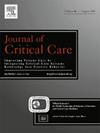危重病人用可乐定和氟哌啶醇控制躁动:回顾性分析
IF 3.2
3区 医学
Q2 CRITICAL CARE MEDICINE
引用次数: 0
摘要
目的探讨可乐定与氟哌啶醇对ICU患者躁动控制的影响。方法本队列研究纳入至少有一次躁动发作(Richmond躁动镇静量表[RASS]评分>;1)用可乐定和/或氟哌啶醇治疗。采用倾向评分匹配和马尔可夫多项逻辑回归,主要结局为给药6小时内躁动控制(- 2≤目标RASS评分≤1)。我们进一步探讨了与伴随用药的关系。结果:我们分析了247例患者的510次躁动发作,其中273例(54%)只接受可乐定治疗,88例(17%)只接受氟哌啶醇治疗,149例(29%)两者都接受。与单用可乐定相比,单用氟哌啶醇(OR 1.00, 95% CI 0.57 ~ 1.76)和双用两种药物(OR 0.83, 95% CI 0.52 ~ 1.32)均未显示躁动控制得到改善。仅氟哌啶醇(调整差值- 44.8 mg, 95% CI -89.1至- 0.5 mg)和可乐定和氟哌啶醇(调整差值- 48.4 mg, 95% CI -85.6至- 11.1 mg)与仅可乐定相比,异丙酚使用量减少相关。同时使用可乐定和氟哌啶醇治疗与较低的阿片类药物使用相关(调整差为- 52.3 mg, 95% CI为-93至- 11.7 mg)。苯二氮卓类药物的使用没有差异。结论本研究发现可乐定、氟哌啶醇或两者治疗对ICU患者躁动控制无显著差异。本文章由计算机程序翻译,如有差异,请以英文原文为准。
Agitation control with clonidine and haloperidol in critically ill patients: A retrospective analysis
Purpose
To investigate the effects of clonidine and haloperidol on ICU agitation control.
Methods
This cohort study included mixed ICU patients with at least one agitation episode (Richmond Agitation Sedation Scale [RASS] score > 1) treated with clonidine and/or haloperidol. Primary outcome was agitation control (−2 ≤ target RASS score ≤ 1) within six hours of medication administration, using propensity score matching and Markov multinomial logistic regression. We further explored associations with concomitant medication.
Results
We analyzed 510 agitation episodes in 247 patients, with 273 (54 %) receiving clonidine only, 88 (17 %) haloperidol only, and 149 (29 %) both. Neither haloperidol only (OR 1.00, 95 %CI 0.57 to 1.76) nor administration of both medications (OR 0.83, 95 %CI 0.52 to 1.32) showed improved agitation control compared to clonidine only. Haloperidol only (adjusted difference − 44.8 mg, 95 %CI -89.1 to −0.5 mg) and both clonidine and haloperidol (adjusted difference − 48.4 mg, 95 %CI -85.6 to −11.1 mg) was associated with reduced propofol usage compared to clonidine only. Treatment with both clonidine and haloperidol was associated with lower opioid usage (adjusted difference − 52.3 mg, 95 %CI -93 to −11.7 mg). There was no difference in benzodiazepine administration.
Conclusion
This study found no difference in agitation control among ICU patients treated with clonidine, haloperidol or both.
求助全文
通过发布文献求助,成功后即可免费获取论文全文。
去求助
来源期刊

Journal of critical care
医学-危重病医学
CiteScore
8.60
自引率
2.70%
发文量
237
审稿时长
23 days
期刊介绍:
The Journal of Critical Care, the official publication of the World Federation of Societies of Intensive and Critical Care Medicine (WFSICCM), is a leading international, peer-reviewed journal providing original research, review articles, tutorials, and invited articles for physicians and allied health professionals involved in treating the critically ill. The Journal aims to improve patient care by furthering understanding of health systems research and its integration into clinical practice.
The Journal will include articles which discuss:
All aspects of health services research in critical care
System based practice in anesthesiology, perioperative and critical care medicine
The interface between anesthesiology, critical care medicine and pain
Integrating intraoperative management in preparation for postoperative critical care management and recovery
Optimizing patient management, i.e., exploring the interface between evidence-based principles or clinical insight into management and care of complex patients
The team approach in the OR and ICU
System-based research
Medical ethics
Technology in medicine
Seminars discussing current, state of the art, and sometimes controversial topics in anesthesiology, critical care medicine, and professional education
Residency Education.
 求助内容:
求助内容: 应助结果提醒方式:
应助结果提醒方式:


